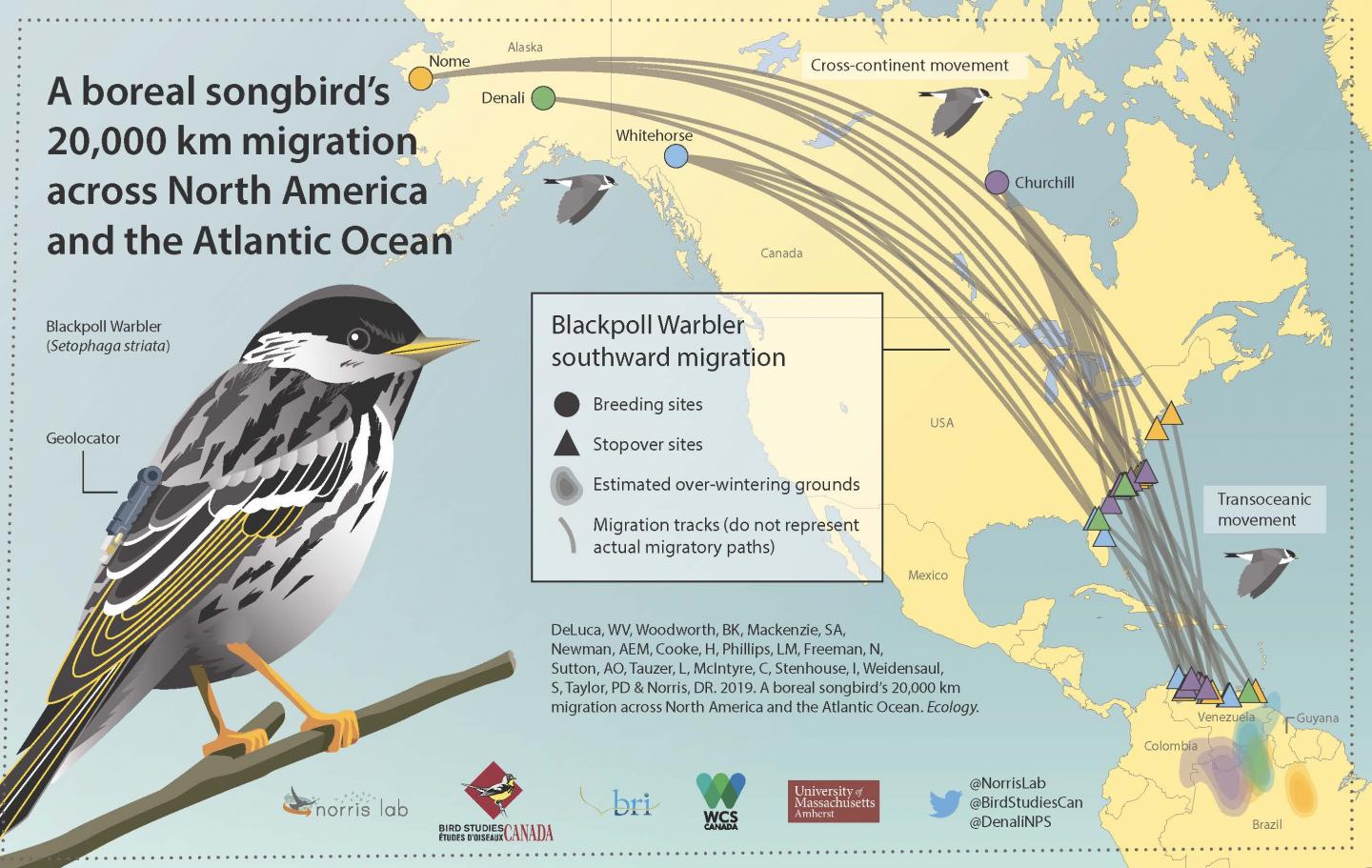UMass Amherst, Canadian researchers identify blackpoll warbler migration routes

Credit: UMass Amherst/University of Guelph
AMHERST, Mass. – Blackpoll warblers that breed in western North America may migrate up to 12,400 miles roundtrip each year, some crossing the entire North American continent before making a nonstop trans-ocean flight of up to four days to South America. Now a new study led by first author Bill DeLuca at the University of Massachusetts Amherst and project lead Ryan Norris at the University of Guelph, Ontario offers details of the feat.
Reporting in the journal Ecology, DeLuca, Norris and colleagues provide new data on the central- and western-nesting blackpolls based on data collected from miniaturized geo-locators harnessed to the birds like tiny backpacks.
Research teams deployed the dime-sized devices, weighing 0.5g and with a 12-month battery life, on male birds at four locations: Churchill, Manitoba; Whitehorse, Yukon Territory; Denali National Park and Nome, both in Alaska. They report recovering 12 tags from Churchill birds and five each from Whitehorse, Nome and Denali, a total of 27.
DeLuca points out that acquiring a better understanding of the full annual cycle for blackpolls is critically important to ecologists. “Not only is it one of the fastest declining songbirds in North America, but it’s also one we probably know least about. Stuart McKenzie, a co-author from Bird Studies Canada, adds that the data collected in this new study “helps fill in the migratory network of the species.”
DeLuca says, “It was fascinating to witness the schedule of this migration. Birds that bred further west had to depart the breeding and wintering grounds much earlier in order to arrive at their destinations on time.” The researchers also observed how much faster the birds’ spring migration is compared to the fall. “Most likely this is due to favorable weather conditions and motivation to establish territories on the breeding grounds as soon as possible,” he adds.
The weather in fall 2016 when this work was done happened to be a very active tropical storm season. DeLuca says, “As a result, we don’t know how typical the migration patterns were. Do they normally depart the North American coast that far south, or was it because of the abnormally active tropical storm season? This could be an important question given how vulnerable blackpolls are on the transoceanic flight.”
Either way, he adds, more and more studies are emphasizing “the incredible importance of South American stopover locations such as northern Colombia and northern Venezuela. Our research is another piece of information highlighting the importance of those regions for migratory songbirds in the Western Hemisphere.”
Further, the study points out the significance of conservation efforts in the Amazon Basin, which is important overwintering habitat for many North American breeding songbirds. In recent years the region has experienced alarming forest loss due to palm oil plantations, DeLuca points out.
“When you take the curve of the Earth into account,” he says, “you see that during the northward, spring migration, birds are basically bee-lining straight from their wintering grounds in South America to their breeding locations in North America.” This study also identifies the importance of the upper Midwest as a stopover for many northward-bound blackpolls. “Clearly in the spring this appears to be a pretty important stopover region for them,” he adds.
DeLuca is continuing to study blackpoll migration by examining the diet required to fuel the impressive journey. He is also working with other researchers to examine the role genetic information plays in determining the timing of migration.
It was in 2015 that DeLuca and Norris, with others, first documented using geo-locators the migration of eastern-breeding blackpoll warblers, which fly nonstop from the northeast United States over 1,500 miles of open ocean to the Caribbean as part of its fall migration. That study provided the first proof of this long-distance feat.
DeLuca now says, “Our 2015 observation pales in comparison to what we witnessed in this new study. Last time we just focused on blackpolls on the southeast fringe of their range, and we didn’t know whether those routes were representative of the wider population.”
###
In addition to UMass Amherst and the University of Guelph, research teams and support for this work came from Nova Scotia’s Acadia University, the University of Queensland, Australia, Bird Studies Canada, the Wildlife Conservation Society of Canada, Denali National Park and Preserve, Alaska, Maine’s Biodiversity Research Institute and Scott Wiedensahl of Schuylkill Haven, Penn.
Media Contact
Janet Lathrop
[email protected]
Related Journal Article
http://dx.




